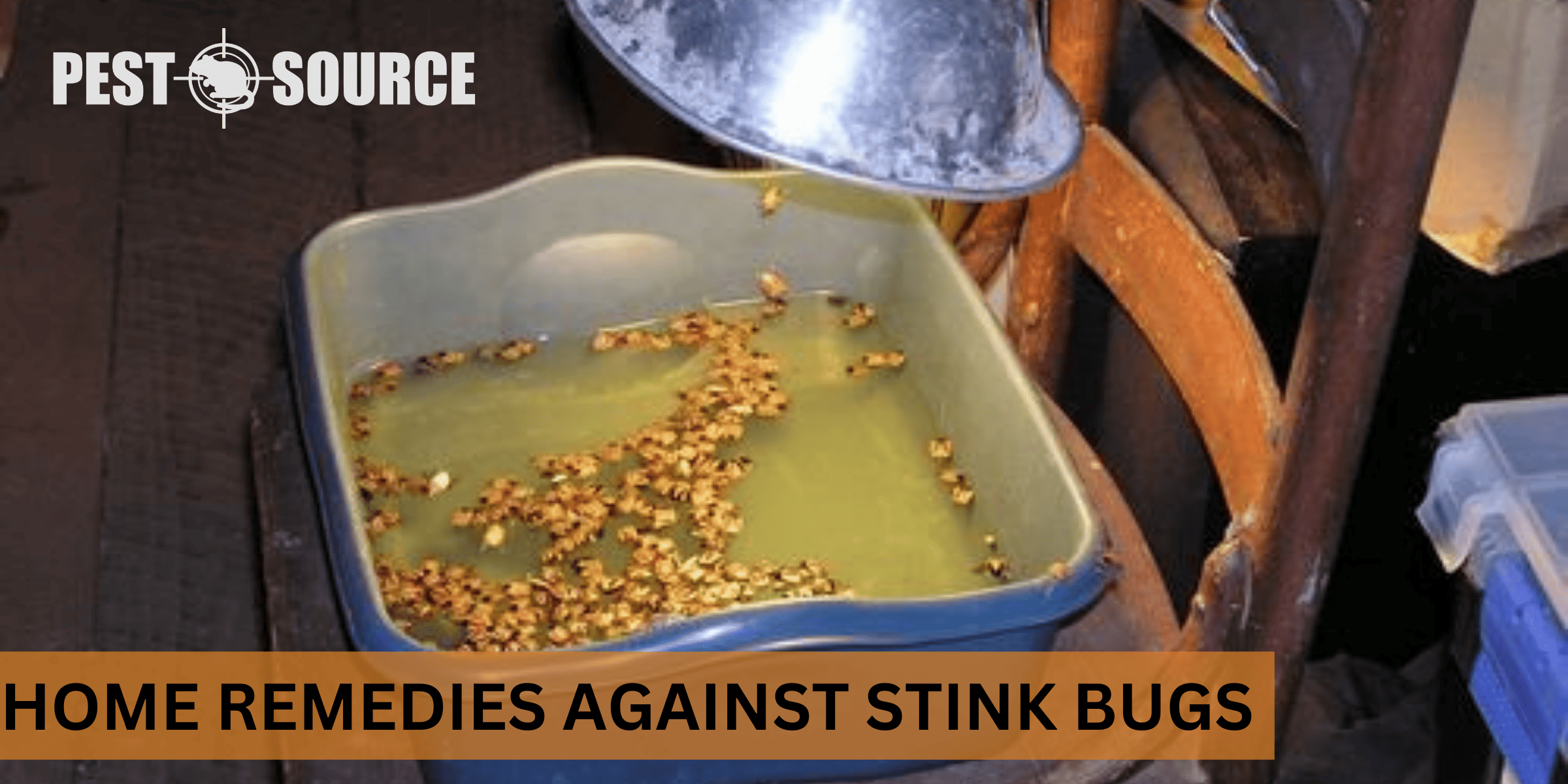If you’ve ever had the misfortune of experiencing a stink bug invasion, you know how imperative it is to promptly and effectively address the issue. These pests can inflict significant damage on your home and garden, not to mention their unpleasant odor when threatened or squashed. But fear not: you don’t need to resort to dangerous chemicals to get rid of stink bugs. In fact, a multitude of effective home remedies exist to help you regain control of your space.
In this article, we’ll dive into proven techniques and measures to help you identify, control, and most importantly, prevent stink bug invasions, using safe, natural, and accessible materials. Let’s reclaim your pest-free home!
POINTS
- Household items, such as dish soap and water, vinegar, diatomaceous earth, hot pepper, garlic, and mint, can be used effectively to either kill or repel stink bugs.
- DIY methods, such as hand removal, vacuuming, and creating homemade stink bug traps, can be effective for immediate stink bug removal.
- When treating specific areas in your home, consider the unique characteristics of that area. For instance, your garden might require use of a garden hose, whilst the porch might be more suited to flypaper or sticky traps.
- After dealing with an infestation, it’s essential to properly clean and dispose of the stink bugs and any lingering smell. Vinegar or lemon juice can help remove any smell from your skin.
- Long-term prevention against stink bugs involves sealing all potential points of entry in your home, regularly cleaning areas that could host stink bugs, and remaining consistent in implementing home remedies even with minor signs of stink bugs.
What Are Stink Bugs and Why Are They a Problem?
What are stink bugs and why are they a problem in homes and gardens?
Stink bugs are pesky pests often found in homes and gardens. Named for the foul odor they release when threatened, these bugs are not only annoying but also damaging to crops and plants. When they invade your home, they can become a massive nuisance.
Why consider home remedies over chemical alternatives in controlling stink bugs?
It’s simple – not only are home remedies cost-effective and readily available, they are also safe for the environment, your loved ones, and pets. Plus, they offer a natural solution for those wishing to avoid toxic chemicals.
How Can You Get Rid of Stink Bugs Using Simple Home Remedies?
There are several homegrown techniques you can leverage to rid yourself of these odorous insects:
Basic Methods for Immediate Stink Bug Removal
Hand Removal
Believe it or not, you can actually pick stink bugs straight off your plants, walls, or furniture. Be sure to wear gloves to prevent a lingering smell on your hands! Stink bugs can be deposited straight into the toilet or placed outside in a plastic bottle to freeze (during cooler months).
Vacuum Method
Another immediate solution is to vacuum stink bugs. This quick and clean approach provides instant relief, but remember to dispose of the vacuum bag immediately to prevent any escapees.
Household Substances That Kill Stink Bugs
Dish Soap and Water
A combination of dish soap and water serves as a compelling homemade stink bug killer. Fill a spray bottle with dish detergent and warm water. Shake until mixed and spray directly on any lurking stink bugs to eliminate them instantly.
Vinegar Solution
Vinegar, potent with acetic acid, is deadly for stink bugs. Create a 1:1 solution of vinegar and water to spray on these unwanted guests.
Diatomaceous Earth
Diatomaceous Earth (DE), a chalky powder made from fossilized marine phytoplankton, is another great remedy. Sprinkle DE around your home or directly on stink bugs for maximum impact. It’s perfectly safe for humans and pets but fatal to many bugs, including stink bugs.
Hot Pepper Spray
Hot peppers make a potent home spray that can literally burn stink bugs. Soak two hot peppers in a quart of soapy water and you have yourself a robust stink bug deterrent.
Natural Repellents for Stink Bugs
Garlic
Garlic’s strong odor can act as a repellent for several insects, including stink bugs. Making a spray is simple. Crush a few garlic cloves, mix them with water, strain, and voila, you have your garlic repellent. Spray it in areas where stink bugs convene.
Mint
Don’t like the smell of garlic? No problem. You can use mint to repel stink bugs. Similar to how garlic works, the robust smell of mint deters stink bugs. Just dilute a few drops of peppermint oil in water and spray at points of entry. If fresh mint leaves are handy, those work equally well.
Essential Oils
Certain essential oils, like peppermint, eucalyptus, lavender, and citrus, can repel stink bugs. Simply dab a few drops of your chosen oil on a cotton ball and place strategically around your home. Alternatively, consider using an essential oil diffuser for your chosen scent.
DIY Methods for Stink Bugs
Sticky Traps
Though you should be mindful as sticky traps could accidentally ensnare beneficial insects, they are effective against stink bugs. Apply these traps near entry points or areas where stink bugs congregate.
Dryer Sheets
Did you know the smell of dryer sheets offends stink bugs? Rubbing dryer sheets on window screens and home entry points is an unconventional yet effective way to keep stink bugs at bay.
Hairspray Method
While hairspray won’t kill stink bugs, it will paralyze them. Once paralyzed, it’s easy to dispose of the bugs by dropping them into a bowl of soapy water, throwing them outside, or flushing them down the toilet.
Garden Hose Technique
Protect your garden from stink bugs by simply dislodging them with a high-pressure jet setting on a garden hose attachment. Monitor the affected plants as the bugs might return.
How to Effectively Use Organic Insecticides Against Stink Bugs?
Going organic is a step towards accomplishing stink bug control effectively while conserving the environment and our health.
Insecticidal Soap
Insecticidal soaps are sprays that kill insects on contact. You can purchase one at your local garden center, or opt for a DIY version by combining 5 tablespoons of dish soap with 4 cups of water. When sprayed directly on stink bugs, this mixture quickly dehydrates and kills them.
Pyrethrins
Pyrethrins are naturally occurring compounds with insecticidal properties that you can employ against stink bugs. Most often, they come in a spray that you can apply directly to kill these pests.
Neem Oil
Neem oil is a natural pesticide derived from the neem tree. Not only is it effective at stunting the growth of stink bugs, but it also repels them. Dilute neem oil with water per the package instructions and spray in affected areas.
What Techniques Can You Use to Lure and Then Kill Stink Bugs?
DIY Stink Bug Trap
You can set up a clever trap using a soda bottle, LED light, masking tape and black electrical tape. By imitating a dark hiding spot with light at the entrance, stink bugs will be lured in but won’t manage to escape.
Damp Towel Technique
Stink bugs are attracted to damp surfaces so you can use this natural behavior to trap them. Simply leave a damp towel on a lawn chair overnight. In the morning, you’ll find a substantial number of bugs clinging to it. These can be swiftly eliminated by dropping the towel into a bucket of soapy water.
Electric Insect Traps
Though a pricier option, electric insect traps are also effective at killing stink bugs. The bright light of the trap attracts the bugs and gives them a lethal shock. Always ensure to follow the manufacturer’s instructions when using these traps.
By creatively using these simple resources, you can manage and control stink bug infestations effectively while minimizing any harm to your environment or loved ones.
How to Address Stink Bugs in Special Areas of Your Home?
Knowing how to address stink bug infestations in special areas of your home is crucial. Here are some tips based on different locations:
In The Garden
Spraying a mixture of dish soap and water on your garden area can help deter stink bugs and protect your plants.
On The Porch
Consider hanging flypaper or sticky traps on your porch. Light based traps are also quite effective here. Remember to replace the traps regularly as stink bugs multiply quickly.
In The Attic
Stink bugs love hiding in dark, warm spots making attics a favorite. Regularly cleaning the attic, sealing any cracks or openings, and using a stink bug trap can keep the bugs at bay.
How to Handle Stink Bug Infestations Outside Your House?
Stink bugs often convene in significant numbers outside homes, particularly in warm temperatures. If you’re perplexed about how to handle this outdoor invasion, don’t worry. A very efficient and straightforward method exists to catch them.
Why are there so many stink bugs outside my house?
In warm weather, stink bugs are drawn to the outside of houses for heat. The exterior walls that receive sunshine and warmth are where they’ll congregate. They can also be found in gardens and vegetation. The primary goal of these bugs is to find a warm, secluded spot to pass the winter, and our homes provide perfect shelter.
How to trap stink bugs outside?
One of the simplest yet efficient trapping methods is the soapy water pan trap. Just take a large pan, fill it with soapy water, and place it under a light source at night. The light source will attract the stink bugs, they’ll aim for the light, get trapped in the water, and drown almost instantly.
This affordable, DIY trap not only helps reduce the stink bug population around your property but is also environmentally friendly, involving no harmful pesticides. Consistency in placing this trap for a few nights will lead to a noticeable reduction in the stink bug population around your home.
How to Deal With the Aftermath of Stink Bugs?
After dealing with an infestation, you might be left not only with dead stink bugs but also a lingering smell on surfaces or even your skin.
How to remove stink bugs?
To remove dead stink bugs without causing an odor, consider vacuuming them or picking them up with a tissue for disposal in an outdoor garbage bin.
How to remove stink bug smell from skin?
Cleaning your skin with lemon juice or vinegar followed by soap and warm water can help remove the stink bug smell. Remember to avoid touching your face or eyes before washing your hands thoroughly as the juice they release can be irritating.
Understanding Stink Bug Behaviors and Preventing Them
Knowing why stink bugs behave the way they do plays a vital role in preventing their reappearance.
Do stink bugs like water?
Stink bugs are attracted to moisture, but they do not necessarily like water. Stink bugs are often found in warm, humid environments, such as near water sources like leaky faucets. This is because they need moisture to survive and to lay their eggs. However, direct streams or a still water surface can deter them, especially if coupled with suitable detergents or repellents. That’s why a soapy water solution can often be a death sentence for these pests.
What are the benefits and drawbacks of using DIY stink bug repellents?
The benefit of DIY stink bug solutions is they are often inexpensive, environmentally-friendly, and pose little to no risk for humans and pets. The drawback, however, can be the time and consistency required for these home remedies to work effectively. In severe infestations, professional pest control may be needed to completely eradicate the bugs.
How to get rid of stink bugs permanently?
To ensure you don’t deal with another infestation, prevention is always the key.
- Seal all openings where stink bugs can enter such as around window and door frames, air conditioning units, soffits, attic vents, and holes in your home’s masonry.
- Regularly clean the areas of your home that can host these bugs, like your attic or garage.
- Cultivate stink bug repelling plants in your garden such as mums, mint, garlic, and catnip.
- Consistently implement the methods mentioned above, even if only minor signs of the bugs are evident.
Conclusion
Getting rid of stink bugs doesn’t have to be a colossal task or burn a hole in your pocket. With simple, everyday items and a little time invested, you can eradicate these pests from your home and garden. The key lies in perseverance and consistent implementation of the methods shared here. Remember, the primary goal of pest control isn’t just to kill, but to implement proactive prevention methods. After all, the fewer pests you have to deal with, the better off you, your family, your pets, and your garden will be!



